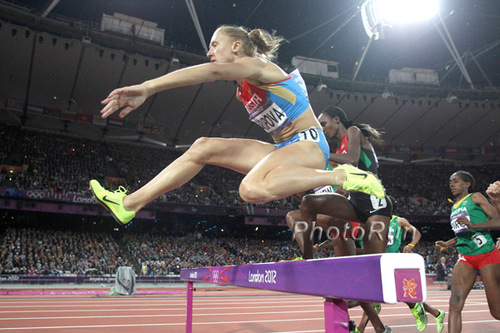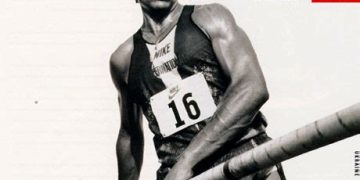Jon Gugala has written his take on the relatively new event, the women’s steeplechase. I have a letter, dated from 1991, from a college coach taking me to task for having put Carla Borlavika on our American Athletics cover running the then newly minted women’s steeplechase. And I quote, ” dear god, after the steeplechase, will you put a women pole vaulter on your cover?” And, we did.
No Water for Old Women
Jon Gugala
August 7, 2012
LONDON – The women’s Olympic steeplechase final ran last night, and though we didn’t see an Olympic record set (which is also the current world record of 8 minutes, 58.81 seconds), we did see a certain changing of the guard. In 2012, the Olympic steeplechase officially became both more immature and immensely more professional.
Go back to the 2008 Olympics, the first year that the event was offered for women (I know, hard to believe it took that long): Gulnara Galkina of Russia curb-stomped a field of women who looked about as organized as the pre-Clint Eastwood Marine Corps platoon in Heartbreak Ridge.
This is not to say that Galkina was not talented; as previously mentioned, her winning time was and still is the Olympic and world record. But there was an almost 27 second gap between places one and 10, and the average age of the field was 26.1 years old (and that is deceptive, since four of those women, including Galkina, were 30 years old or older). Galkina was leading a group of women in the sunset of their careers.
The sport itself was so new for women that of those top 10, all but one (10th place Anna Pierce, nee Willard, of the U.S.) set bests of some sort. Five area- or national records were notched, as if an influx of a modicum of skill suddenly infiltrated one of those weird, rarely contested feats like how many times you can fit your body through a tennis racket in one minute (Braeden Brice Kershner, USA, 22 times).
Contrast that with this year’s steeplechase final: When Yuliya Zaripova of Russia won her first gold medal, her 9:06.72 was a personal best, but only Habiba Ghribi’s silver medal performance of 9:08.37 was a national record. Ethiopia’s Sofia Assefa, who took the bronze in 9:09.84, was close, less than a second off national record pace (9:09.00), but that was about it.
And that wasn’t the only difference this year. In those top 10 spots, the average age was 24.2 years old, almost two years younger than in 2008, and the average age of the top three was 26 (two years exactly). The oldest age in that top 10 was 28, and there was a spread of just over 20 seconds. These women are young, and they will be competing on a contested international stage for years to come.
So what does this all mean? It mean’s the women’s steeplechase has lost that new car smell. The overwhelming lack of national, Olympic, and world records at this Olympics means that the event has finally become competitive, no longer an exhibition, with women racing tactically. We rarely expect a man to set a world record in an Olympic distance or mid-distance event; why should we expect it from the women?
(And let’s not forget the best part of this event for women: Unlike the men’s steeplechase, where Kenya holds an international vice grip, there’s yet to be a nation establish itself as the women’s perennial Olympic powerhouse. International competition equals a worldwide interest.)
And the U.S. has cause to celebrate: they’re part of this new generation emerging, as 21-year-old Emma Coburn, who last year finished 12th in the Daegu World Championships, finished ninth in her first Olympic Games in a PR 9:23.54. While Briget Franek wouldn’t do as well, finishing last in 14th, she’s no old bag, either, at 24. Both can be expected to remain players on the international stage for years to come.
But as the saying goes, a picture’s worth a thousand words, and the picture from the women’s steeplechase wasn’t so much the young women at the front. It was Galkina, now 34, stepping off the track before the first kilometer. She would not finish the race in which the youth are choking out the old growth.
We should applaud Galkina: she was the midwife that helped birth the women’s steeplechase on the international level, and she leaves a fine legacy. But her children are growing up. They’re here, and they’re dreaming of a future far the beyond what their parents ever envisioned.






















